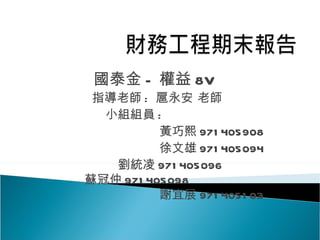1. 國泰金 - 權益 8V
指導老師 : 扈永安 老師
小組組員 :
黃巧熙 971 405908
徐文雄 971 405094
劉統凌 971 405096
蘇冠仲 971 405098
謝宜展 971 4051 03
2. 權證的定義
投資人以支付權利金的方式換得在未來某一段
時間,以預先約定好的價格向發行人要求轉換
或收取價差的機會。
4. 發行機構:國泰金
簡 稱: 051 742 群益 8V
權證種類:美式認購權證
上市日期: 201 2/04/24
最後交易日: 201 2/1 0/1 9
到期日: 201 2/1 0/23
原始發行單位數量: 1 0000 張單位
履約價: 30 元
標的股價: 30.2 元
行使比率: 0.250
價內外:價外 0.5% 0
5. 以少量的資金,參與股票行情
高槓桿,高報酬
靈活搭配操作,創造多種策略
風險有限
7. 履約價格
權證持有人向發行人買入標的股票之約定價格
價平、價外、價內權證
跟目前股價差不多的,就是價平 (S = K) 權證。
離目前股價還有一段距離的,就是價外 (S < K) 權
證。
想要買的價格比現在便宜的,就是價內 (S > K) 權
證。
8. 認購權證的價值是由以下兩個價值來組成的 :
1 . 內含價值 = 股價大於履約價的部分 * 行使比率
(30.2- 30)* 0.25= 0.05
2. 時間價值 : 認購權證價 - 內含價 ( 根據網路上
資料可得知認購權證價格為 0.94 ,於是我們可以
得知時間價值為 0.89(0.94- 0.05)
認購權證價 = 內含價值 + 時間價值
9. B la c k- S c ho le s 選擇權評價模型公
式 S σ 2
ln 0 + r +
*T
K K
d1 =
σ T
ln S 0 σ2
+ r −
*T
K K
d2 =
σ T
C = S 0 * N ( d1) − K * E − rt (d 2)
10. 群益 8V 目前股價在 30.2 ,到期後履約價 30
無風險利率 1 .43% ,隱含波動率 0.2099
S0 30.2
K 30
R 0.0143
σ 0.2099
T 0.4575
11. 將數字代入公式
30.2 0.2099 2
ln + 0.0143 +
* 0.4575
30 2
d1 = = 0.440031
0.20990 0.4575
30.2 0.2099 2
ln + 0.0143 −
* 0.4575
30 2
d2 = = 0.298057
0.20990 0.4575
12. 將數字代入公式
C = S 0 * N ( d1) − K * E − rt (d 2)
C = 30.2 * N ( 0.440031) − 30 * E −0.006542 ( 0.298057 ) = 1.840916
S 0= 30.2
d 1 = 0.440031
d 2= 0.298057
RT = R* T= 0.01 43* 0.4575= 0.006542
13. 日期 收盤價 S 相對價格 s/s-1 每日收益
μ i =ln(s/s-1)
4 月 24 日 30.7
4 月 25 日 31.15 1.0147 0.01455
4 月 26 日 30.8 0.9888 -0.01130
4 月 27 日 30.95 1.0049 0.00486
4 月 30 日 30.9 0.9984 -0.00162
5月2日 31.7 1.0259 0.02556
5月3日 31.8 1.0032 0.00315
5月4日 31.65 0.9953 -0.00473
5月7日 30.8 0.9731 -0.02722
5月8日 31.1 1.0097 0.00969
5月9日 30.4 0.9775 -0.02277
5 月 10 日 30.2 0.9934 -0.00660
5 月 11 日 29.9 0.9901 -0.00998
STDEV=0.01504
14. S=
1
n −1
∑ i =1 µ i −
n 2 1
n( n − 1)
(
∑ i =1 µ i
n
) 2
= 0.1504
15. 步驟一:挑選標的股票,判斷未來走勢
步驟二:挑選價內外程度
步驟三:挑選到期日遠近
步驟四:挑選流動性
16. 價內外程度的選取決定於投資人對於標的股票後市的看法。例如:當
投資人認為近期標的股票將小漲,則可買進價外程度較低的認購權證。
若投資人認為標的股票將大漲,則可買進價外程度較高的認購權證,
當行情來時,即可獲得高報酬。
價內外 (% ) : ( 標的收盤價-最新履約價 )÷ 最新履約價 × 1 00 。拿
我們的資料計算出價內外 %
(29.85- 30) ÷ 30 × 1 00= - 0.5
由此可得知我們選的權證是屬於價外
17. 存續期間對權利金影響說明
與權證價格呈正向關係,非直線型,又稱時間價值。
權證離到期間愈遠的,存續期間愈長,標的股價有愈多機會可以大幅
超過履約價格,所以權證價格應會愈高。
反之,存續期間愈短的,權證失效的可能性愈大,超過履約價格的機
會也會降低,因此權證價值愈低。
離到期日愈接近,時間價值流失愈快。
18. 與權證價格呈正向關係,但一般市場利率對於權證價值影響力道並不如其它
因素來的大。
當市場利率愈高時,資金借貸成本比較高,權證價格也會比較高。
當市場利率愈低時,資金借貸成本比較低,權證價格也會比較低。
